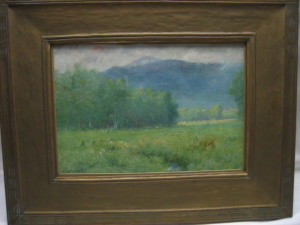We’ve reached number 1 on our top 10 list of antiques and collectibles, “paintings by listed artists”. Although this column will focus on paintings, other art forms like sculpture, gold and silversmithing, art pottery and art glass can also be highly desirable and valuable.
A web search shows rare paintings turning up in thrift shops and homes. A 19th Century painting by Giovanni Batista Torriglia was dropped off at a Goodwill store in Virginia in 2013. The work was valued at $20,000. Someone dropped off a painting by early 20th century landscape artist John Fery at a San Diego St. Vincent DePaul store in June. Its estimated value is $25,000. A painting that was being used as “a bulletin board” was sold at a United Kingdom auction house for nearly $1.3 million.
Many older New England homes have paintings that have been on the wall for decades and sometimes centuries. Perhaps because the owners have lived with them for so long they may pay little attention to them. Paintings are one of the first items that we check when we are called upon to handle an estate. We found an Edmund Adler painting in an Amherst estate that brought nearly $10,000. An English hunting scene painting from a Leominster home brought well over $5,000. Many other paintings have brought figures in the $1,000’s including works by Joseph Greenwood. Greenwood was born in Spencer and studied art at the Wilbraham Academy. The Worcester Art Museum describes him as “Worcester’s most noted landscape painter”. The works that we sold of his were of Mt. Wachusett and other Worcester county scenes. Even the smaller sized paintings of his we handled have brought between $2,000 and $4,000.

Smaller Greenwood paintings like this one of Mt. Wachusett sell in the $2,000 to $4,000 range at our auctions
You can do some of your own detective work with your art. First, you want to see if it is actually a painting or a print. Use a powerful magnifying glass to examine it closely. If you see dots from the printing process you know you have a print. If it has a date when it was published it is also a print. Look for brush strokes with oil paintings. However, there are some prints though that are raised to look like brush strokes. Watercolors are a little more difficult to decipher than oil paintings, but a good magnifier can help you determine whether it is painted or printed. If you do have a painting, check the signature. A painting by a listed artist (one who has training with a record of selling prices) can be researched in books or online. You can see auction records and get an idea of what yours might be worth.
It was nice meeting some regular readers of this column and other members of the Douglas Senior Center at last week’s appraisal day. Please contact me if you’d like to schedule an antique appraisal fund raiser event for your organization.
Contact us at: Wayne Tuiskula Auctioneer/Appraiser Central Mass Auctions for Antique Auctions, Estate Sales and Appraisal Services www.centralmassauctions.com (508-612- 6111), info@centralmassauctions.com




